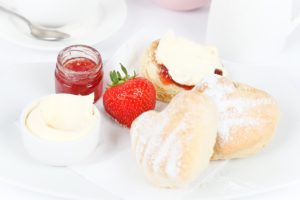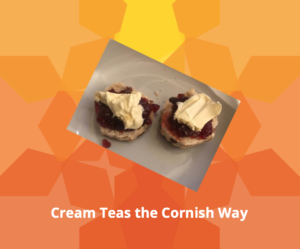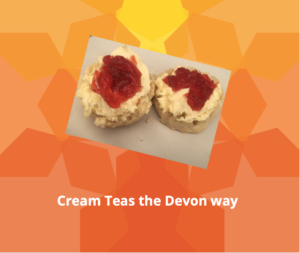The Cornish and the cream tea
As a Cornish girl who shares her time between Cornwall and London I feel it is only right to educate you London folk on the ‘proper’ way to eat a cream tea.
I am straying a little from all things massage and muscle related but I figured I may as well write something that I had a little knowledge about (and learn some more in the process!!)
A few years ago I attended a networking event through the Athena Network to promote my business ‘Keheren Therapy’ (keheren being the Cornish word for muscle) . At this event I couldn’t help but notice the different way that people ate their scones, some jam first, some cream first, some with a knife and fork, some like a sandwich. I saw all manors of ways of eating cream teas!
I decided I wanted to research this a little further. Whilst to many a cream tea is associated with holidays in the west country, for me a Cornish girl growing up in Cornwall they were a way of life, a bit like pasty’s were also. Perhaps however many of you will be unfamiliar with a delicacy that my grandma used to give us growing up which was ‘Thunder and Lightning’. This consisted of thick white bread, clotted cream and a generous helping of Golden Syrup poured on top!!
I can remember the smell of my great grans kitchen, it was always smelling of baking and due to this she aptly became known as ‘Bun Gran’. I guess that my gran must have learnt recipes from her Mum (Bun Gran) but alas I was too young to appreciate my grans recipes when she was sadly died when I was a teenager. Another delicacy not unknown during my childhood was my Grans Cornish splits. I remember these tasting like a sweet, soft bread and again filled with clotted cream and jam (always strawberry jam) . Here is a recipe for Cornish splits for all those interested.

The history of the cream tea
It is unclear where the scone originated. It is believed to date back to 1513 as mentioned in the Oxford English dictonary. With some documentation stating they started as early as the 11th century.
Schoonbrood is a Dutch word meaning fine white bread, and this may have been the origin. But the Scots Gaelic word sgonn meaning a large mouthful or shapeless mass may have also been the origin.
Scones became an important part of taking tea or afternoon tea. It is believed that Anna, the Duchess of Bedford (1788–1861) is credited with making scones a way of curbing that afternoon hunger.
It has also been cited that the queen prefers jam first…… surely we cannot dispute this when it comes to English tradition.
Jam or cream first?
The rivalry between the two West Country counties of Devon and Cornwall has been on-going for years. Unable to agree on important subjects like who invented the Pasty, the cream tea is no exception……….. cream tea consists of a freshly baked scone, fruity jam and clotted cream. The ongoing argument between Devon and Cornwall is …. Which comes first, Jam or cream


Pronunciation
The pronunciation of ‘scone’ differs dependent on where you live, discussion surrounds should it rhyme with gone or bone? This is how the oxford english dictionary explains the pronunciation of the word
https://www.oxfordlearnersdictionaries.com/definition/english/scone
In the Cornish language they are skons n.coll or skonsen.

So whilst you are waiting for the spas to open or you are waiting to book a treatment with us at Keheren Therapy, why not enjoy a cream tea on National Cream Tea day – June 26th 2020. Enjoy it any way you like!

